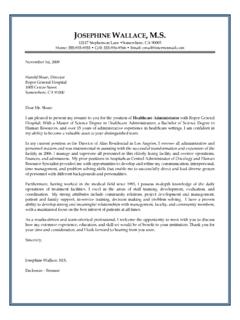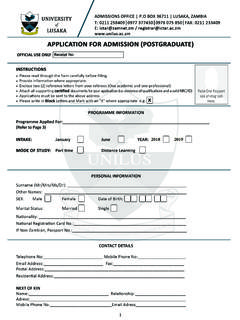Transcription of ZAMBIA STRATEGIC COUNTRY GENDER …
1 ZAMBIA . STRATEGIC COUNTRY GENDER . assessment . A Report of The World Bank Prepared by Mabel C. Milimo, PhD. Monica L. Munachonga, MPhil Lillian Mushota, LLM. Nelson Nyangu, MPS. Sr. Auxilia Ponga, PhD. JUNE 2004. ACRONYMS. ACBF African Capacity Building Foundation AIDS Acquired Immune -Deficiency Syndrome AIEMS Action to Improve English Maths and Science ARPT Adaptive Research Planning Team ARV Anti-Retroviral (Drugs). BSA British South Africa (Company). CAS COUNTRY Assistance Strategy CA Constituent Assembly CBO Community based organization CEDAW Convention on the Elimination of All Forms of Discrimination Against Women CIDA Canadian International Development Agency CRC Constitutional Review Commission CSO Central Statistical Office CSOs Civil Society Organizations DDCC District Development Coordinating Committee FAWEZA Forum for African Women Educationalists ZAMBIA GIDD GENDER In Development Division HDI Human Development Indicators HIPC Highly Indebted Poor Countries HIV Human Immune Virus ICPD International Conference on Population and Development ICT Information Communication Technology ILO International Labor Organization JUDAI Jule Development Associates International LCMS Living Conditions Monitoring Survey MCDSS Ministry of Commun ity Development and Social Services MMD Movement for Multi-Party Democracy MMR Maternal Mortality Ratio MoE Ministry of Education
2 MoFNP Ministry of Finance and National Planning MoLSS Ministry of Labor and Social Security MoL Ministry of Lands MoLA Ministry of Legal Affairs MPS Master of Policy Studies MoSTVT Ministry of Science Technology and Vocational Training MoSYCD Ministry of Sport Youth and Child Development MTCI Mother-to-child-infection M2000 Movement 2000. NAC National HIV/AIDS, STD, TB Counci l NGP National GENDER Policy NGO Non-governmental organization NORAD Norwegian Agency for Development Cooperation OVC Orphans and Vulnerable Children PAGE Programme for the Advancement of Girls Education PRSP Poverty Reduction Strategy Paper RNE Royal Netherlands Embassy SADC Southern African Development Community SCGA STRATEGIC COUNTRY GENDER assessment SIDA Swedish International Development Agency SPA STRATEGIC Plan of Action SSA Sub-Saharan Africa STD Sexually transmitted disease TB Tuberculosis TBA Traditional Birth Attendant TFR Total Fertility Rate TNDP Transitional National Development Plan UNDP United Nations Development Programme - i- UNECA United Nations Economic Commission for Africa UNFPA United Nations Fund for Population Activities UNICEF United Nations International Children's Education Fund UNIP United National Independence Party USAID United States Agency for International Development VSU
3 Victim Support Unit WiLDAF Women in Law and Development in Africa WLSA Women and Law in Southern Africa YWCA Young Women's Christian Association ZARD ZAMBIA Association for Research and Development ZDHS ZAMBIA Demographic and Health Survey ZNWLG ZAMBIA National Women's Lobby Group - ii - TABLE OF CONTENTS. ACRONYMS i ACKNOWLEDGEMENTS vi FOREWORD vii EXECUTIVE SUMMARY viii CHAPTER 1: INTRODUCTION AND COUNTRY A. Objectives of the SCGA .. 1. B. Methodology .. 2. C. COUNTRY Context .. 2. D. International Conventions ..10. CHAPTER 2: GENDER PROFILE FOR ZAMBIA ..11. A. Socio-economic roles of men and B. Female/male access to and control over resources ..19. CHAPTER 3: GENDER PROFILE: Human development indicators ..25. A. Education 25. B. Health C. GENDER and D. Decision-making ..43. CHAPTER 4: GENDER PROFILE: LEGAL AND INSTITUTIONAL. A. The dual legal and judicial systems ..50. B. The option between civil and customary laws ..51.
4 C. International Conventions and D. The E. Statutory law in ZAMBIA ..54. F. List of statutory laws with GENDER -discriminatory provisions ..56. G. Customary H. Legal literacy/education and improved access to legal/judicial services 58. CHAPTER 5: ECONOMIC COSTS OF GENDER INEQUALITIES, IMBALANCES, AND LEGAL A. Economic costs of GENDER inequalities in socio-economic roles, access to and control over productive resources ..60. B. Economic costs of GENDER inequalities in human development indicators 61. C. Disposable Income of H/holds + Non distributed profits + Net direct taxes= National Income ..62. D. Analysis 66. E. Economic costs of GENDER inequalities relating to legal and institutional frameworks, societal norms and practices ..67. CHAPTER 6: CONCLUSION AND RECOMMENDED INTERVENTIONS69. A. Conclusion 69. B. What then? Recommended Interventions ..70. - iii - Annex 1: Working Definitions And Sex-Role Stereotyping In Local Language Annex 2: Crops By Sex, Need For Fertilizer Use, Drought Resistance &.
5 Use (Choma, Southern Province)..77. Annex 3: Percent Of Women Who Have No Say In Household Decisions By Employment Annex 4: Men And Women In Politics And Decision Making ..79. Annex 5: Development Of The Legal Framework In ZAMBIA ..82. BIBLIOGRAPHY 86. - iv - LIST OF FIGURES. Figure 1: Comparison of Time Allocation for Key Domestic Tasks ..15. Figure 2: ZAMBIA Time Figure 3: ZAMBIA Average Monthly Hours Worked in Eastern Province, Figure 4: Basic School Enrolment Rates By Sex, Level And Province, Figure 5: Secondary School Enrolments By Grade and Sex, Figure 6: Repeaters by Sex, Grades 1 to Figure 7: Reasons for dropping out ..31. Figure 8: Fertility Rates By Number of Years in School ..33. Figure 9: Condom Use By Marital Status, Residence and Figure 10: The Benefits of Educating Males & Females Beyond Secondary Figure 11: Causal, Effect and Impact of GENDER Inequalities on Economic Growth, Poverty &Human Well Being in ZAMBIA .
6 68. LIST OF TABLES. Table 1: Division of Labour by Crop and Activity (Values in hours per Lima) ..16. Table 2: Income Allocation System By Employment Status Of Table 3: Access to land in Government Settlement Schemes by men and women 22. Table 4: Literacy Rates By Age Group, Sex And Residence, 1990-2000. (Percentage) ..26. Table 5: Response to Maternal Health Services by education Table 6: HIV prevalence by Table 7: Use of condoms by type of partner (for Women) ..39. Table 8: Use of condoms by type of partner (for Men) ..40. Table 9: Expected compensation of Gra duates by level of Education and Opportunity Costs Incurred while in School (2002 Zambian Kwacha per year per graduate) ..64. Table 10: Expected compensation of Graduates by level of Education for entire working life (At 2003 ZK nominal)..66. LIST OF MATRICES. Matrix 1: Men and Women's access to & control resources in rural households ..20. Matrix 2: Definition and GENDER implications of the allocation Matrix 3: Summary of Factors Contributing To Inequalities In GENDER Roles, Access To And Control Over Resources.
7 23. Matrix 4: Portrayal of women and men in decision-making through proverbs ..47. Matrix 5: Status of domestication & implementation of International Instruments .53. Matrix 6: - v- ACKNOWLEDGEMENTS. The ZAMBIA STRATEGIC COUNTRY GENDER assessment (ZSCGA) is a collaborative effort between the World Bank, Government of ZAMBIA and Zambian GENDER experts. The team appreciates the invaluable technical inputs that many stakeholders brought to the assessment . Many development partners concerned with GENDER issues and supporting both government and civil society in this important area contributed to the substance of the assessment . Stakeholders from among the cooperating partners, universities, government and civil society, and private sector participated in a workshop to review the assessment , and brought a wealth of information and analysis to the process . Many made themselves available for any one-on-one consultations as needed.
8 The GENDER in Development Division (GIDD) in Cabinet Office is responsible for GENDER within the Government of ZAMBIA . Its Permanent Secretary, Sr/Dr A Ponga, played a pivotal role in backstopping the study, both technically and logistically. Her staff were equally supportive. The direct involvement of GIDD. facilitated the sense of ownership of the SCGA by the Zambian Government and civil society. The assessment was undertaken under the supervision of the GENDER team of the Africa Region of the World Bank, specifically Mark Blackden and Shimwaayi Muntemba. It benefited from insights of Malcolm Ehrenpreis, GENDER and Development, the World Bank, who reviewed the draft; and of the ZAMBIA COUNTRY team, Africa Region, the World Bank. - vi - FOREWORD. ZAMBIA has put in place many development instruments, the overarching being the Poverty Reduction Strategy Paper (PRSP), which was finalized in 2002, but whose review may be undertaken in 2006.
9 Development partners have their own assistance strategies, that are nevertheless guided by the PRSP. ZAMBIA has also committed itself to the Millennium Development Goals (MDG). The STRATEGIC COUNTRY GENDER assessment (SCGA) offers ZAMBIA and its development partners an opportunity to look at GENDER as a means of informing and improving the effectiveness of the COUNTRY 's poverty reduction strategy and of meeting its MDGs in a meaningful manner. By looking at how GENDER can inform development and poverty reduction, the development community acknowledges GENDER as a social and economic issue that must be captured in policy analysis. The debate on the importance of GENDER in economic and social policy analysis revolves around two issues. The first issue is premised on conclusions drawn by GENDER and development economists and social scientists that GENDER inequalities impede economic growth and frustrate efforts to reduce poverty.
10 Eradicating or reducing GENDER disparities is seen, in this scenario, as an effective way of achieving economic growth, reducing poverty and securing livelihoods at the household level. A cost benefit analysis (CBA) is applied to show the economic gains of investing in girls, as well as in boys who have been preferred by governmental policy makers and families. The second issue originates from the notion that GENDER inequalities are bad in and of themselves. GENDER equity is the concept that all human beings, both men and women, should be free to develop their personal abilities and make choices without the limitations placed by stereotypes, rigid GENDER roles, and prejudices. There is now strong advocacy for GENDER equity. This is justified through the rights-based approach to development. GENDER , then, is both an economic and social issue. One reinforces the other. Empowerment that comes with stronger economic positions has impacts on social status, while social/cultural issues affect economic performance.

















